Melanoma usually affects the melanin cells in your skin. It is also known as malignant melanoma. It is one of the most common skin cancers and the number of people diagnosed is increasing rapidly each year in Ireland and around the world. Over 1,197 people are diagnosed with this disease on average each year. In Ireland more women are diagnosed with melanoma but more men die from it.
Watch this video to hear from Irish people who have been affected by melanoma.
Risks and causes of melanoma
- Ultraviolet light- UV light comes from the sun. Over exposure to sunlight can cause patches of rough, dry skin called solar keratoses, which increases your risk of melanoma by up to 4 times
- Moles- The more moles you have on your body, the higher your risk of melanoma. You should be very careful about exposing yourself to the sun and should keep an eye on all your moles.
-
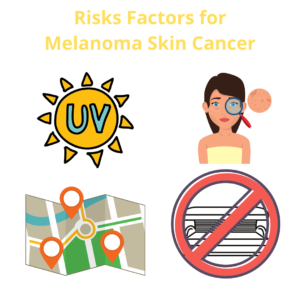
Rare birthmarks– A very rare type, called a congenital giant melanocytic naevus, can develop into a melanoma. They are very common on the buttock.
- Skin colour and freckling– People who are very fair skinned, especially those with fair or red hair; blue, green or grey eyes and those with lots of freckles are more at risk of developing melanoma.
- Sunburn– People who have had sunburn are twice as likely to get melanoma as those who have not. The risk is higher if you have had sunburn several times in your life.
- Where you were born- Fair skinned people born in a hot country, for example Australia, have a higher risk than people who went to live in a hot country as a teenager or people with similar skin colouring who live in cooler climates.
- Sun exposure now and then- People who are exposed to strong sunlight now and then, like when holidaying in a hot country, are more at risk of melanoma than people who are continuously exposed to sunlight
- Sunbeds– Using a sunbed, even just once, increases your risk of melanoma by 20%. Using a sunbed before the age of 35 increases your risk by almost 60%. Never, ever use sunbeds.
Visit Spot the Difference
What you can do
Get to know the normal appearance of your skin and any moles you may have. Then, learn your ABCDE’s and check your skin regularly- about once a month. Because melanoma affects both men and women, everyone needs to become aware of their own skin and check themselves.
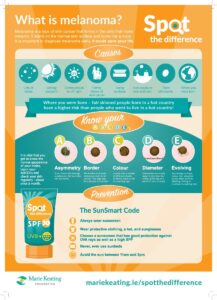 A-asymmetry
A-asymmetry
If you draw a line through a melanoma, the two sides will not match
B- border
The boarder of an early melanoma tend to be uneven. The edges may be scalloped or notched.
C- colour
Most healthy moles are all one colour. A mole with a number of different shades of brown, black or tan is a warning sign. Melanomas may also be blue, red or some other colour
D- diameter
Melanomas are usually larger in size than the rubber at the top of a pencil (¼ inch or 6mm)
E- evolving
Any change- in shape, colour, size, elevation (height), or any other trait, or a new symptom like bleeding, itching or crusting is a warning sign
Visit Spot the Difference
What melanoma looks like
 Dark mole
Dark mole
The photo below shows a very dark mole. Darkening is one possible sign that a mole is becoming cancerous and could be a melanoma. This mole is about a centimetre across.
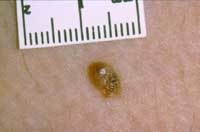 Inflamed mole
Inflamed moleThe photo below shows a mole that has an area of inflammation around it. The inflamed area is about 7 millimetres at its widest but you can see that the original mole is much smaller than that. Inflammation is another sign that a mole may be developing into a melanoma and needs to be checked out by a doctor.
 Melanoma with irregular border
Melanoma with irregular borderThe photo below shows the irregular outline of a melanoma. Normal moles are usually much rounder, with smooth borders.
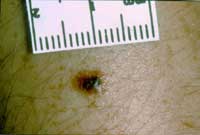 Melanoma with irregular shape and colour
Melanoma with irregular shape and colour
Below is a very small melanoma. It is only about 4 or 5 millimetres across. But you can see clearly that it is not the same colour throughout. It also has an irregular shape. Irregular colour and shape are signs that should be checked by a doctor.
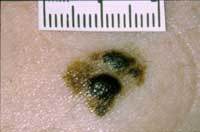 Spreading melanoma
Spreading melanomaThe picture below shows clearly a melanoma that is spreading out from a normal mole. If you have a mole that has changed in this way, you should see your doctor as soon as possible.
The pictures are just a guide and if you are worried about any moles or skin changes it is important to see your GP to get them checked.
All pictures are courtesy of Cancer Research UK.
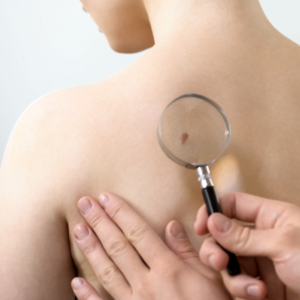 Diagnosing melanoma
Diagnosing melanoma
If you have a suspicious looking mole, go to your GP. If your GP thinks the mole may be becoming cancerous, you will need to have it removed and looked at under a microscope. This is called an excision biopsy. This is usually done by a specialist skin doctor called a dermatologist.
The dermatologist may use a tool called a dermatoscope to closely examine the abnormal area on your skin. If the doctor decides that you need to have the mole removed, you will be administered a local anesthetic. The doctor then cuts out the whole mole and 2 mm of tissue all around. The tissue is sent to the laboratory for testing. You will need some stitches and the doctor or nurse will tell you how to look after your small wound. Follow up will be arranged. If the mole does not contain any cancerous cells, you will not need any more treatment. If the mole contains any cancerous cells, you may need to have more tests.
If your mole contained cancerous or precancerous cells, a pathologist will carefully check the biopsy tissue in the laboratory. Your doctor will ask you to go back into hospital for an operation to remove more tissue from around the area of the melanoma. This operation is called a wide local excision.
Treatment for melanoma
The main treatment for early and locally advanced melanoma is surgery. Advanced melanoma can also be treated with surgery though treatment will depend on the type and size of the melanoma, where it is found and the organs it affects. Treatments may also include topical chemotherapy or immunotherapy chemotherapy, radiotherapy, photodynamic therapy and biological therapies.
If you have already been diagnosed with melanoma, you may find it helpful to connect with people who are going through something similar. The Melanoma Support Ireland facebook group offers support and shares experiences. You can find the group by clicking on the button below.
Join Melanoma Support Ireland
Remember Many skin changes may be harmless, but if you notice a new or changing mole, visit your GP without delay. It is never too late to start protecting your skin. Follow the SunSmart code. Look for the UVA logo on your sunscreen bottle. Check your skin using the ABCDE’s. Early detection saves lives.
Donate to Marie Keating
We hope you found this information useful. The Marie Keating Foundation offers all of our services for free. Help support people at every step of a cancer journey by making a donation today.
DONATE
